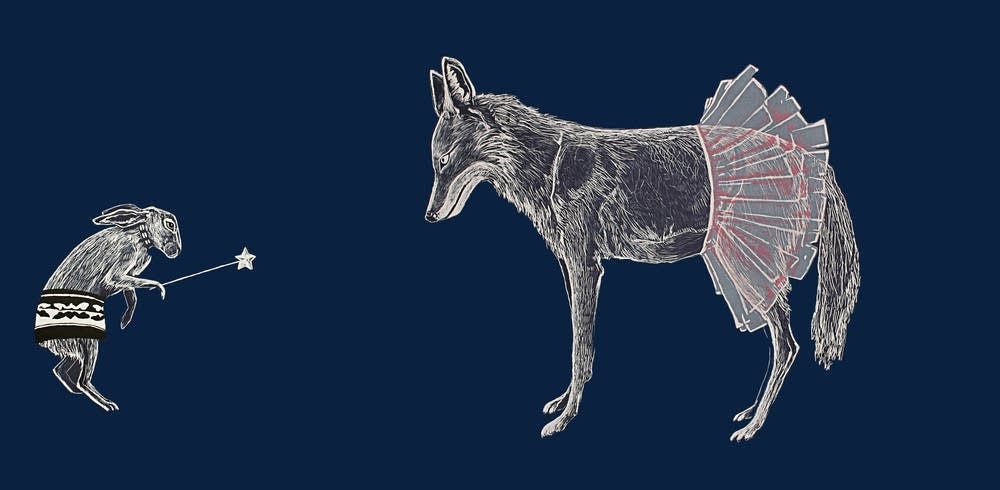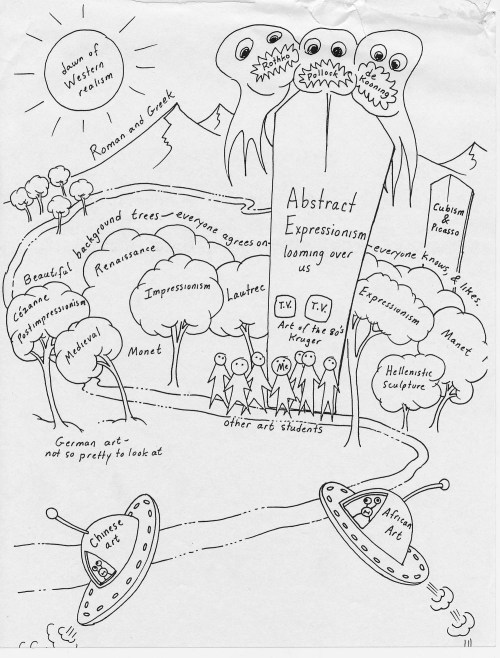 |
Julie Buffalohead, Trickster Showdown, ~2019
Visual Art: includes forms such as painting, drawiing, architecture, sculpture, installation, performance art, ceramics, photography, video and audio art, crafts, conceptual art.... |
Current usage of the term "visual arts" includes fine art as well as applied or decorative arts and crafts,
Discrepant: lacking agreement; differing; at variance; inconsistent.
Modernism(s): in the traditional definition, a 19th and 20th century movement, in art, philosophy, and other spheres, seated in Western society. At center, the push for artists to Make it New, often by responding to one another's work, or to the modern world, defines the many-faceted movement (which we are very likely still inside)
Contemporary art is the art of today, produced in the second half of the 20th century or in the 21st century. Contemporary artists work in a globally influenced, culturally diverse, and technologically advancing world. Their art is a dynamic combination of materials, methods, concepts, and subjects that continue the challenging of boundaries that was already well underway in the 20th century. Diverse and eclectic, contemporary art as a whole is distinguished by the very lack of a uniform, organising principle, ideology, or "-ism". Contemporary art is part of a cultural dialogue that concerns larger contextual frameworks such as personal and cultural identity, family, community, and nationality.
How would you describe our time? What distinctive traits of the present, here, can you identify?
Course Design and Syllabus intro.

Art History Map


 John Ogilby's, Road from London to the Lands End 1675 (Wikimedia).
John Ogilby's, Road from London to the Lands End 1675 (Wikimedia).
What does your map of art history look like?
 |
Katsushika Hokusai Yejiri Station, Province of Suruga, ca. 1832 |
Some reflections on Teaching
–––––––––––––––––––––––––––––––––––––––––––––––––––––––––––
A friend and
colleague told me once that teachers often fail to state what they believe is
obvious, and that this hinders the success of the class. So, you may find some
of the materials on the rest of this page obvious, but I didn’t want to miss
the obvious
I teach because I love having conversations about art and
ideas. I look forward to meeting a new group of people each year, and I love
learning settings. I teach because I like and respect my students, and enjoy
hearing new ideas. Please share your ideas, opinions, insights, and
observations freely, and listen to, reflect upon, and respond openly to those
of others.
I believe learn is a verb…. Please
come to class ready to think, ask questions, build bridges, make knowledge. So:
·
Please Talk. Ask questions. If you are curious,
ask a question. If you don’t understand something, ask a question. If you hear
a word you don’t know, ask a question. If you would like more info, ask a
question. Asking questions provides the fastest way to get information.
Please feel free to ask me any question about art, art history, writing, childhood, birds, animals, stories or anything not on my lists. I welcome all questions.
· Please take good
notes… I believe in marginalia, in drawing your own connections between what
happens in class and what you are thinking about and working on in your own
time, taking a few moments to write down an idea that something in class
triggered, making the material your own. Always have notebook and pencil in
class, even if your computer is handy.
·
Listen
actively and practice the art of conversation. Sharing ideas comprises the
course’s most fundamental activity.
·
By talking
and listening, we open ourselves to the course and to others, making ourselves
vulnerable—to each other and to learning.
·
Learning takes
hold through play, experimentation and reflection. Be willing to play with the
materials, to take risks, and take time to mull over the ideas in your own
ways.





Comments
Post a Comment